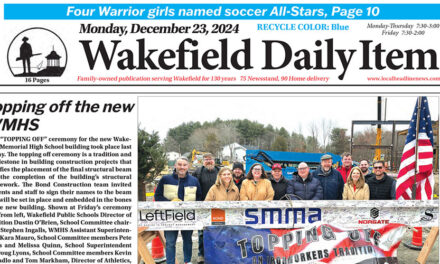Published in the May 31, 2019 edition.
By MARK SARDELLA
WAKEFIELD – In his first full meeting a chairman of the Town Council, Edward Dombroski last night outlined a sweeping agenda for the upcoming year.
Dombroski said that he formulated what he called his “Wakefield 2020 Vision” (Fiscal Year 2020 begins July 1) after meeting personally with each member of the Town Council. He said that he incorporated ideas from residents as well.
Dombroski broke his agenda into 10 broad categories beginning with infrastructure, although he noted that the proposals were not listed in order of importance.
Under infrastructure, he said that he expected the “Envision Wakefield” downtown revitalization and infrastructure program, which he has taken a lead role in advancing, to continue moving forward.
He also acknowledged the need to continue to improve parking options for both merchants and customers in the town’s business districts.
Beautification and improvements to the Greenwood business district were also cited as a priority by Dombroski, who noted that Greenwood has never gotten the same level of attention that the downtown has.
Under the subject of taxes, Dombroski promoted the idea of residential tax relief for taxpayers across the board. He noted that the town has offered some tax relief to seniors but said that the town should be looking to expand that relief to individuals and families with children in order to make Wakefield more affordable.
He proposed reviewing valuations of commercial properties in determining tax obligations. He also advocated targeted tax incentives for environmental site cleanups or to spur economic development.
In the area of buildings and facilities, Dombroski called for a strategy for the Wakefield Memorial High School building if it is accepted into the Massachusetts School Building Authority funding program and a contingency plan if it is not accepted.
He said that he expected the Public Safety Building Reassessment Committee to continue developing a revised plan that could be implemented to address that building’s needs.
He proposed revisiting a proposal for a local hockey rink.
Other areas he touched on included reviewing the utilization of the Nahant Street Yard Waste Facility and addressing the flooding along the Mill River.
Under the umbrella of community outreach, Dombroski called for the development of a comprehensive communications strategy for the town, including such things as a digital newsletter and enhanced social media notifications. He suggested a more responsive and engaged system for residents to report issues as well as a web site overhaul with features to improve transparency.
He also proposed separate sessions outside of regular meetings where citizens could sit with the full Town Council for the purpose asking questions and sharing ideas.
Under the heading “Economy and Financials,” Dombroski floated the possibility of either hiring an economic development director or forming an Economic Development Council. He also called for reviewing the town’s budget process and creating a long-term budget forecasting plan as well as a master plan for capital building projects.
On the subject of development, he proposed looking at the ongoing redevelopment of Foundry Street with an eye toward preserving some of the district’s commercial elements.
He also advocated looking at the overall development picture as the town works toward reaching its affordable housing threshold. He proposed looking for more ways to promote commercial development in industrial zones like Audubon Road as well.
Under the heading “Community,” Dombroski called for a more aggressive approach to prioritizing the cleanup of Lake Quannapowitt and improvements to the surrounding shoreline.
He proposed finding ways for the town to reverse the trend of losing shade trees every year.
He called for addressing issues of downtown safety and vibrancy in ways that address the needs of both business customers and disadvantaged individuals.
Addressing the longstanding traffic safety issues outside Wakefield Memorial High School was another area that Dombroski hoped to see addressed in the coming year.
He noted that there has been some local interest in creating a community garden.
Dombroski called for better engagement with local students and developing opportunities for multi-generational connections, possibly in partnership with the Council on Aging.
He also advocated developing a more robust arts and culture community and support for community social and cultural events.
Under a heading Dombroski called “Operations,” he talked about creating defined policy priorities, goals and objectives for the town to advance through its boards and committees.
Addressing “Social Supports and Wellness,” he advocated improved coordination and support of social services for veterans and addiction recovery and for better strategies to curb youth vaping in coordination with the Board of Health.
He also called for eradication of illegal activity at local massage parlors, including human trafficking.
Finally, Dombroski advocated for more dynamic collaborations with state legislators and officials to promote the town’s interests and secure funding. He also called for more collaboration between the town and local nonprofits as well as increased cooperation among local boards and committees.
Town Councilor Jonathan Chines wanted it known that while other board members had met with Dombroski and may have contributed ideas, “it doesn’t mean that all seven of us have bought into every item.”
Dombroski stressed that he had met with and communicated via phone and email with all members of the board and any ideas that were submitted were wrapped into his roadmap for the coming year.




